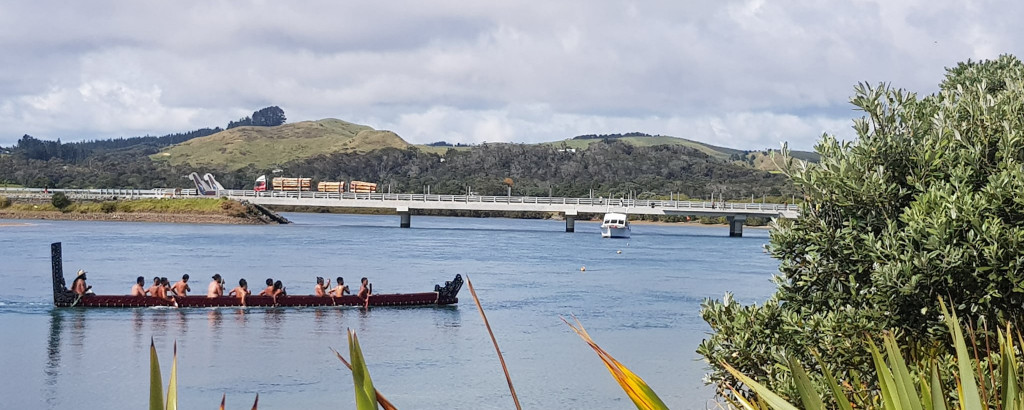The smartest bridge in New Zealand opens in style

The community of Taipa was today celebrating the official opening of the smartest bridge in New Zealand.
The new wifi-enabled, two-lane Taipa Bridge has been opened to traffic since Labour Weekend, but today marked the official handover of the bridge to the community by Associate Transport Minister Shane Jones – who performed the ribbon-cutting ceremony – and the rollout of the free Taipa Community Wifi.
Hundreds of people from the local community joined local hapū, business representatives, the New Zealand Transport Agency (NZTA) and its construction partners at the event, which started with a dawn blessing and the unveiling of the carved wood inserts on the waka end panels adorning both ends of the bridge.
Joseph Stuart, Northland Inc’s General Manager Business Innovation and Growth, and chairman of Northland’s Digital Enablement Group, thanked local hapū, Far North District Council, NZTA, NB Smart Cities – a company specialising in smart city turnkey solutions – and McKay, an electrical engineering and contracting business, for their input into the Taipa Community Wifi project, and said the benefits for the town would be significant.
“The key thing is that the wireless provides free connectivity to a community where it didn’t previously exist; that’s important in itself, but it will also aid visitors to the area and make Taipa more accessible and connected.”
John Carter, QSO, Mayor of the Far North District Council, said: “It’s a really exciting moment to see the completion of the first pilot in community wifi being successfully rolled out across the region.”
The community project, Stuart added, had been three years in the making. “We’re planning to put two or three more in place across Northland in 2020, and this is just the start. Take the role of NZTA, for instance, it is not solely about building bridges for them, it is also about their engagement in economic development, and community wifi is an important component of that initiative.”
The state-of-the-art Smart Cities street lights, positioned at both ends of the road adjacent to the bridge, will be equipped with wifi, CCTV and a programmable driver that will improve safety and connectivity in the area while also controlling lighting output and saving energy costs. “This is a unique solution to the problem of connectivity, and the first time street lights have been deployed in this way in Northland,” said Stuart.
“This technology will have a hugely positive impact right across the board, from education to tourism, to local history, culture and the overall safety of the area. It will improve engagement within the community while also unearthing a host of new opportunities and possibilities for the people of Taipa.”
The most striking visual feature of the new $19 million bridge is undoubtedly the tauihu (prow) and taurapa (stern) end panels of a seafaring waka adorning each end of the structure. It acknowledges Taipa as one of the first landing places in New Zealand of the Polynesian explorer Kupe.
The waka hourua (a traditional double-hulled canoe) design and the pou whenua came about after extensive collaboration between NZTA and local hapū representatives of Ngati Kahu.
“It was really important that we worked closely with local hapū to acknowledge Taipa’s rich history, the significance of its river and estuary, and the role of the bridge in the town’s future,” said Andrew Thackwray, NZTA Senior Manager Project Delivery. “It’s a great day for Taipa and the project team.”
The construction of the bridge was identified as a key priority in the Tai Tokerau Northland Economic Action Plan (TTNEAP), which is being facilitated and supported by Northland Inc, the region’s economic development agency.
Launched in 2016 and refreshed in 2019, the TTNEAP brings into focus a group of projects that together are contributing to the transformation of Northland’s economy.
Progress is being made through identifying opportunities and inspiring innovation to encourage further investment, boosting sustainable jobs and productivity, building capability and empowering and engaging communities to reach their full potential.
"